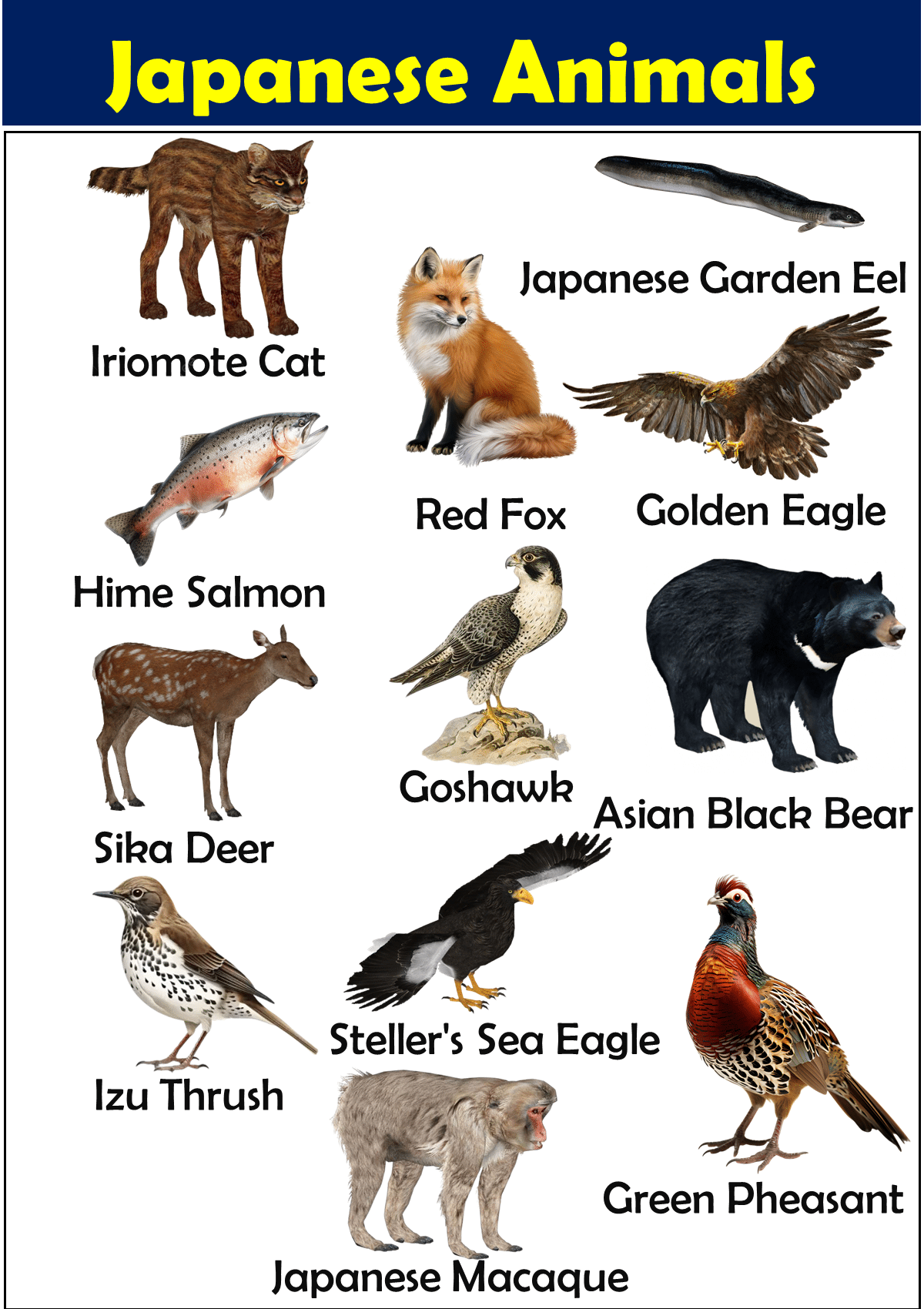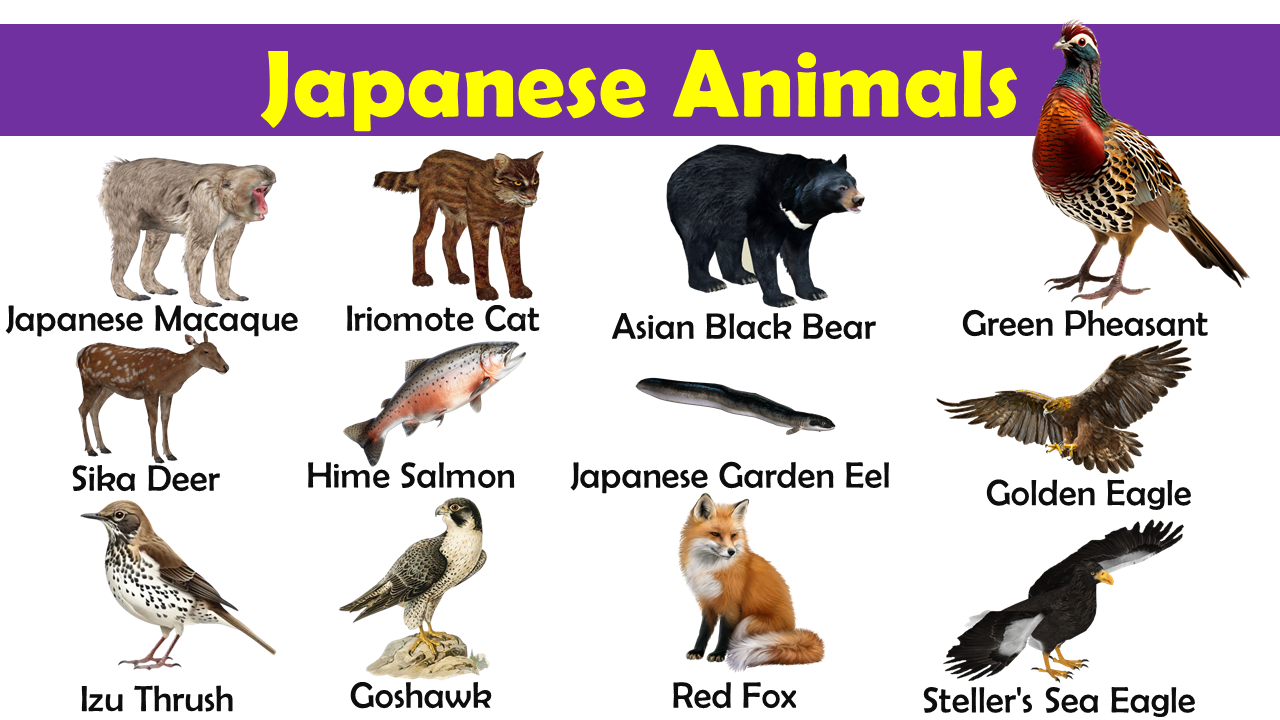Japan is a fascinating country with a rich variety of animals, some of which are found nowhere else on Earth. In this blog post, we’ll explore the world of Japanese animals, from the majestic Japanese macaque to the delicate red-crowned crane. These animals offer a window into Japan’s unique habitats and the natural beauty of its islands. As we learn about these creatures, you’ll also pick up new and interesting English vocabulary words related to animals. Let’s start our journey and meet these amazing animals of Japan!
What are Japanese Animals?
Japan, an archipelago stretching through several climatic zones, hosts a unique array of wildlife. The diverse environments from the northern cold regions of Hokkaido to the subtropical islands of Okinawa support various species, from large mammals like bears to unique bird species and marine life. Japanese animals also include numerous endemic species, which have evolved to adapt to the local conditions of the isolated island nation.
List of Japanese Animals
- Japanese Macaque
- Tanuki (Raccoon Dog)
- Red-Crowned Crane
- Sika Deer
- Japanese Serow
- Green Pheasant
- Steller’s Sea Eagle
- Hokkaido Wolf (extinct)
- Iriomote Cat
- Amami Rabbit
- Okinawa Rail
- Japanese Giant Salamander
- Tsushima Leopard Cat
- Blakiston’s Fish Owl
- Japanese River Otter (extinct)
- Japanese Black Bear
- Hokkaido Brown Bear
- Japanese Dormouse
- Crested Ibis
- Japanese Fire-Bellied Newt
- Japanese Honeybee
- Ussuri Brown Bear
- Japanese Woodpecker
- Copper Pheasant
- Yonaguni Horse
- Nihon Kamoshika (Japanese Antelope)
- Yamato Salamander
- Golden Eagle
- Japanese Weasel
- Asian Black Bear
- Japanese Flying Squirrel
- Japanese Bitterling
- Ryukyu Flying Fox
- Okinawan Habu (snake)
- Japanese Garden Eel
- Snow Monkey
- Japanese Sea Lion (extinct)
- Red Fox
- Lidth’s Jay
- Nipponia Nippon (Crested Ibis)
- Ogasawara Flying Fox
- Mandarina Frog
- Bonin Petrel
- Okinawa Woodpecker
- Japanese Murrelet
- Keyaki (Zelkova tree)
- Japanese Trench (marine life habitat)
- Sea Pineapple (sea squirt)
- Daito Fruit Bat
- Japanese Thrush
- Ryukyu Minivet
- Japanese Grass Lizard
- Goshawk
- Japanese Robin
- Japanese Grosbeak
- Stejneger’s Stonechat
- Bonin White-eye
- Gifu Butterfly
- Small Japanese Field Mouse
- Akita (dog breed)
- Shikoku (dog breed)
- Tosa (dog breed)
- Japanese Chin (dog breed)
- Izu Thrush
- Japanese Squirrel
- Ryukyu Kingfisher
- Hime Salmon
- Japanese Wigeon
- Hokkaido Red Squirrel
- Koshin Pond Frog
Explore More Animal Vocab:
Australian Animals | Safari Animals | Mammals Animals

Japanese Animals Vocabulary and Their Facts
1. Japanese Macaque
The Japanese macaque, or snow monkey, is famous for its ability to survive in cold climates, often seen bathing in hot springs in winter. Native to Japan, they are highly social and intelligent, with complex social structures and behaviors, such as washing their food and participating in snowball fights.
2. Tanuki (Raccoon Dog)
Tanuki are native to Japan and are known for their mythical representation in Japanese folklore as mischievous shapeshifters. In reality, they are canids that hibernate—an unusual trait for the family. They are omnivorous, eating anything from insects to fruits and small animals.
3. Red-Crowned Crane
The red-crowned crane is considered a symbol of luck, longevity, and fidelity in Japan. It is one of the rarest cranes in the world, known for its elegant mating dance. Conservation efforts in Japan focus on preserving its habitat to prevent further decline.
4. Sika Deer
Sika deer are native to East Asia and are revered in Japanese culture, freely roaming in places like Nara Park where they are considered sacred. They are adaptable and can live in a range of habitats but are threatened by habitat loss elsewhere.
5. Japanese Serow
The Japanese serow is a goat-antelope native to the Japanese forests. It is recognized by its shaggy coat and short horns. The serow is a national symbol of wildlife conservation in Japan, having once faced the threat of extinction.
6. Green Pheasant
The green pheasant, or Japanese pheasant, is the national bird of Japan. It is native to the Japanese archipelago and is related to but distinct from the common pheasant. It is known for its striking plumage and adaptation to the Japanese landscape.
7. Steller’s Sea Eagle
Steller’s sea eagle is one of the largest eagles, with a heavy yellow beak and striking black and white plumage. It winters on the northern Japanese coasts and is a powerful predator, primarily feeding on fish and water birds.
8. Iriomote Cat
The Iriomote cat is a critically endangered wild cat species found only on the Japanese island of Iriomote. It is one of the smallest wild cats, leading a secretive and nocturnal life, and is threatened by habitat loss and a very limited range.
9. Amami Rabbit
The Amami rabbit is an ancient and endangered species native to Amami Ōshima and Tokuno-shima Islands. It is known for its dark fur and small ears, living a nocturnal life mostly in the forests, and is considered a living fossil.
10. Okinawa Rail
The Okinawa rail is a flightless bird found only on the island of Okinawa. It is critically endangered due to its limited range, habitat loss, and predation by introduced species like mongooses.
11. Japanese Giant Salamander
The Japanese giant salamander is one of the largest salamander species in the world, capable of growing up to 1.5 meters long. It lives in rivers across southwestern Japan and is known for its slow metabolism and long lifespan.
12. Tsushima Leopard Cat
The Tsushima leopard cat is a small wild cat found only on Tsushima Island. It is nocturnal and elusive, feeding on small animals and birds. This cat is a designated natural monument in Japan and is critically endangered due to habitat loss and road accidents.
13. Blakiston’s Fish Owl
Blakiston’s fish owl is the largest owl species in the world, found in northern Japan. It relies on pristine river habitats to hunt fish, and its survival is threatened by habitat degradation and logging.
14. Japanese Black Bear
The Japanese black bear is found in the mountainous forests of Japan’s main islands, excluding Hokkaido. It is smaller than its American cousins and is considered vulnerable due to loss of habitat and human encroachment.
15. Hokkaido Brown Bear
The Hokkaido brown bear is found on Japan’s northernmost island, Hokkaido. It is the largest carnivore in Japan and plays a significant role in the cultural heritage of the Ainu people, the indigenous people of Hokkaido.
16. Japanese Dormouse
The Japanese dormouse is a small rodent known for its ability to hibernate for up to seven months a year. It inhabits the deciduous and mixed forests of Japan, feeding primarily on nuts, fruits, and insects.
17. Crested Ibis
Once extinct in the wild in Japan, the crested ibis has been reintroduced successfully through conservation efforts. It is a symbol of environmental conservation in Japan, known for its beautiful red face and white plumage with pinkish hue.
18. Japanese Fire-Bellied Newt
This brightly colored amphibian is known for its vibrant orange belly, which acts as a warning signal to predators. It is found in wetlands and rice paddies across Japan and is popular in the pet trade.
19. Japanese Honeybee
The Japanese honeybee is adapted to the local climate and flora, known for its unique defensive behavior against hornets, encasing them in a ball of bees to elevate their body temperature and kill the intruder.
20. Ussuri Brown Bear
The Ussuri brown bear, also found in Hokkaido, is similar to the Hokkaido brown bear but also ranges into Russia and China. This bear is adapted to cold climates and has a diet that includes fish, fruit, and small mammals.
21. Japanese Woodpecker
The Japanese woodpecker is endemic to Japan and is noted for its role in the ecosystem as a pest controller, feeding on insects found in wood. It is recognized by its distinctive drumming sounds used to communicate and mark territory.
22. Copper Pheasant
The copper pheasant is a brightly colored bird native to the Japanese islands. It is known for its beautiful iridescent copper-colored plumage and skittish nature, rarely seen in the dense underbrush it prefers.
23. Yonaguni Horse
The Yonaguni horse is a small breed native to Yonaguni Island, part of the Ryukyu Islands. It is known for its hardiness and ability to survive in tough conditions, historically used for farming and transportation.
24. Nihon Kamoshika (Japanese Antelope)
The Nihon Kamoshika, or Japanese serow, is a native ungulate that is both a national symbol and a protected species. It is adept at navigating the steep and rugged terrain of Japan’s mountainous regions.
25. Yamato Salamander
The Yamato salamander is endemic to Japan, particularly known for its presence in clear, cool waters. It is sensitive to water pollution, making it a key indicator species for environmental health.
26. Golden Eagle
The golden eagle in Japan is revered as a majestic and powerful bird of prey, found in remote mountainous areas. It is a skilled hunter, feeding on a variety of small to medium-sized mammals and birds.
27. Japanese Weasel
The Japanese weasel is small and agile, found throughout much of Japan, including several remote islands. It plays a crucial role in controlling rodent populations but can also pose a threat to native bird species.
28. Asian Black Bear
The Asian black bear in Japan is found on the islands of Honshu and Shikoku. It is known for its distinctive “V” marking on its chest and is smaller than its Siberian relatives, adapted to life in dense forests.
29. Japanese Flying Squirrel
The Japanese flying squirrel is a nocturnal mammal that glides between trees using a flap of skin between its limbs. It is known for its large eyes, which help it see in the dark, and its shy, elusive nature.
30. Japanese Bitterling
The Japanese bitterling is a small freshwater fish famous for its unique reproductive strategy, laying eggs inside live freshwater mussels where the young can develop in safety. This relationship showcases an unusual form of mutualism with mussels.
